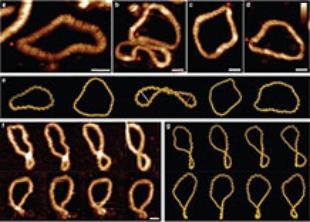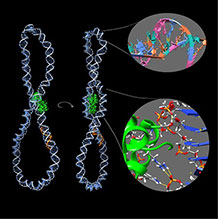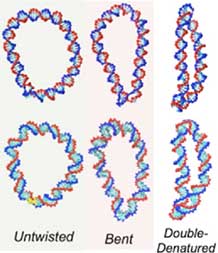DNA supercoiling

DNA topology is an essential interplay between the spatial configuration of the genetic material and its accessibility to major DNA structural transactions. In most organisms, DNA is maintained under-wound or supercoiled and presents transient supercoiling in both the positive and negative directions due to processes like replication and transcription. In turn, torsional stress is relieved by the coiling of the DNA helix around itself, which requires bending deformation and contributes to genome structure, and by the opening of the double helix, which provides an underlying regulatory switch for transcription/replication initiation.
We are describing supercoiled DNA at atomic level by molecular dynamics simulations and contrast our results with experiments like atomic-force microscopy [1]. We can observe how the double-helical structure of DNA is disrupted and how this process is influenced by proteins [2, 3]. We also have observed the creation of closed DNA loops mediated by proteins which is a fundamental structure on the regulation of genes.


- ALB Pyne, A Noy, K Main, V Velasco-Berrelleza, MM Piperakis, LA Mitchenall, FM Cugliandolo, JG Beton, CEM Stevenson, BW Hoogenboom, AD Bates, A Maxwell, SA Harris (2021). “Base-pair resolution analysis of the effect of supercoiling on DNA flexibility and major groove recognition by triplex-forming oligonucleotides” Nature Communications, 12, 1053. https://www.nature.com/articles/s41467-021-21243-y
- T Sutthibutpong, C Matek, CJ Benham, GG Slade, A Noy, C Laughton, JPK Doye, AA Louis and SA Harris (2016). Long-range correlations in the mechanics of small DNA circles under topological stress revealed by multi-scale simulation. Nucleic Acids Research, 44, 9121-9130. DOI: 10.1093/nar/gkw815
- A Noy, A Maxwell, SA Harris (2017). “Interference between triplex and protein binding to distal sites on supercoiled DNA” Biophysics Journal, 112, 523-531. DOI: 10.1016/j.bpj.2016.12.03
